Understanding Egg Freezing and Egg Donation
Every living organism has cycles in life. The human cycle involves moments for psychomotor development (childhood), maturation (adolescence), reproduction (late adolescence, early adulthood), late adulthood, and senescence. These cycles were dictated by nature thousands and thousands of years ago. In those times the human cycle in life was designed to last 35 years. Thanks to our capability to create and adapt, we developed wise ways to survive, build and modify the environment in our favour, which recently lead us to a life expectancy that varies from 74 to 84 years in western Europe. But regardless of our efforts to transform the exterior and creating shelter, professions, money, clothes, medicine and food, we haven’t been able to modify our genes. Understand this concept helps us understand why infertility is a growing problem in the world.

Nowadays in certain countries in Europe the average female age of first child is 32 years. This means that many women will try to conceive later. The way nature chose to decrease fertility was through a drop in the quality in a woman’s eggs. The major difference between eggs and sperm is that eggs are as old as the female is. The eggs a woman has today are the same eggs she was born with. This means that a 38-year-old woman, ovulates 38-year-old eggs. In men, on the other hand, hundreds of millions of spermatozoa are produced each day and for a spermatozoa to be produced it takes 72-74 days. This means that the spermatozoa men ejaculate are only a few months old. For a woman, trying to conceive at ages were the egg quality is poorer makes it difficult and sadly sometimes unachievable.
How can egg freezing help us “freeze” time?
What if we could freeze our eggs at the time when their proportion of good to bad eggs was best? Then we would be able to use those eggs later on, hence improving chances of achieving that so desired motherhood.
Studies show that the optimum age to freeze eggs is between 30 and 35 years old (the American Society of Reproductive Medicine is pushing the ideal age to less than 33). This doesn’t mean one cannot freeze later or earlier, it just means that the chances of success are lower with advancing female age thus needing more eggs to achieve a baby.
This is why egg freezing should be considered in women that are in their thirties and are planning on having children later. The way it works is very similar to IVF. By giving ovarian stimulating hormones, fertility centres encourage the development of not one, but many follicles. Follicles are small sacs that develop in the ovaries were the eggs mature and are ovulated. Most of these follicles should have an egg that is released into the fluid contained in this sac. These eggs are harvested and then vitrified (meaning freezing really quickly).
The survival rates after the thawing of these eggs have changed and improved in the last few years. Nowadays over 90% of these eggs survive the thaw. Most people sadly still think that only 10% survive. The strategy of freezing eggs has become so effective that it is now the standard of fertility preservation for women before starting treatment for cancer in which chemotherapy or radiotherapy can destroy their eggs.
Egg donation and how it affects babies appearance
For many women, the best age to freeze eggs has passed and are now at ages where fertility treatments offer poor results and have no eggs of their own in storage. These are women in their early or mid-forties. In this age group, success rates with IVF are between 1-20% depending on how far into their forties they are and other variables.
Many times these women are faced with only two options: egg donation and adoption. Egg donation will always be considered the last resort, the plan “B”, but with a 50-60% chance of giving a couple a healthy child, it is a great plan “B” to have!
But what does it mean to use the eggs from another person? It’s like using a mould or template to produce a face mask. If I had to make ten facemasks that were identical, I would probably carve the face in a wooden block that I would then fill with clay. Once the clay dries, I would remove it from the block of wood and that would be my face mask. This is exactly what egg donation is! We would use the donor’s genes and the male partner’s genes to produce that template. 100% of what will produce the face mask (100% of the baby) comes from the mother, not from the donor. Every single cell, protein, down to the last little hair comes from the mother’s body.
Thousands of women are opting more and more for egg donation. As this study showed, the increase in treatment with egg donation has drastically increased over the past years. This is a reflection, not only of an increase in our age when trying to conceive, but also an acceptance, a change in cultural opinion about egg donation.
If you are considering fertility treatment, wants to proceed with egg freezing or use the advantage of egg donation to try to conceive, please get in touch with our professionals. We will be glad to guide you through the process.

